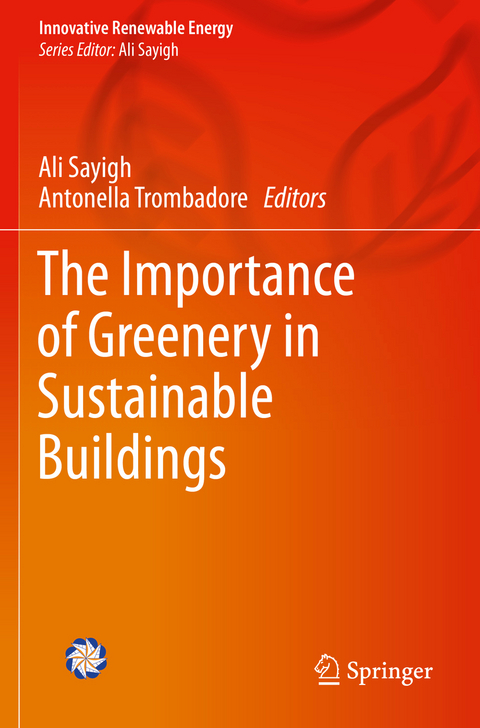
The Importance of Greenery in Sustainable Buildings
Springer International Publishing (Verlag)
978-3-030-68558-4 (ISBN)
Dr. Ali Sayigh is Chairman and Founder of the World Renewable Energy Congress and Council; Director General of World Renewable Energy Network (WREN); Chairman and Founder of the Arab Solar Energy Society; and Past Chairman of the UK Solar Energy Society. Dr. Sayigh was recently elected to chair the Iraqi Energy Institute, and he actively consults on renewable and sustainable energy issues for a number of international organizations, including UNESCO, ISESCO, UNDP, ESCWA, & UNIDO. Dr. Sayigh was Director of Solar Seminars at ICTP Trieste, Italy from 1977-1995; Professor of Solar Energy at King Saud, Kuwait, and Reading Universities from 1969 to 1994, and Professor of Engineering at the University of Hertfordshire from 1994 to 2004. He was the founding expert in Renewable Energy at AOPEC. He is Fellow of the Institute of Energy; Fellow of the Institution of Electrical Engineers; and Chartered Engineer. He has published more than 400 papers and has contributed to and edited more than 30 books. He has been Editor and Editor in Chief of several international journals including Renewable Energy and the International Journal of Environmental Sciences and Technology and Editor-in-Chief of the Major Reference Work Comprehensive Renewable Energy. He is fellow of many societies including The Royal Society of Art. Antonella Trombadore, PhD, is a Professor in the Department of Architecture at the University of Florence, where she is also a senior researcher at the ABITA Interuniversity Research Center. Dr. Trombadore received a PhD in Architectural Technology and an MSC in Energy Management from the University of Florence. Her areas of professional expertise are in the in the fields of project management, integrated projects, sustainable urban design, energy conscious design, low energy buildings, sustainable architecture and bioclimatic design, communications, and dissemination strategies. She is team leader of several European Research Projects in the field of architectural integration of innovative solutions for energy retrofitting action, nearly zero buildings as well as integrated smart process for AbitareMediterraneo, multi-issues platform as interactive Network for technical regulations management, technologies data base and best practice dissemination activity. She is also a Collaborator for the management of the European Master Course "Sustainable Design and Technologies for Built Environment" and post-graduate courses in Bioclimatic Architecture and Energy Saving in Buildings at the University of Florence.
Introduction.- Green in Building: Adaptive Design of Green Facades and Vertical Farming for Resilient Architecture.- Food in the City: Urban Farming and Greenery in Buildings for Green and Circular Economy.- Guidelines of Sustainability Issues and Greenery Buildings Infrastructure Implementation in Bahrain.- Municipality of Bahrain, Kingdom of Bahrain.- Green Walls as Vertical Farming & Thermal Insulation in Buildings.- Case Study: "ETTIJAH" in Sustainable Building in Hot Climates.- The Role of Natural Resources in the Courtyard Houses of Hot Arid Climate of Iran.- The Use of Vegetation in Arid Climates for Sustainable Building Environments.- Urban Vegetation and Microclimatic Comfort in Warm Climates.- Urban Green Coverage Globally: Importance of Urban Farming in Improving Sustainability, Lifestyle and Viability of Buildings and Cities.- Rooftop Greenhouses: Smart and Inclusive Design.- From Vernacular to Sustainable Contemporary Architecture: Urban Green and Patios.- An Integrated Approach to Planning Sustainable Green Cities.- Built Environment Multi-Scale Greening: Tradition and Innovation.- Green Dream: Regenerate Cities Through Nature.- When Photosynthesis Powers Buildings.- Recent Developments in the Implementation of Greenery in Sustainable Building in the Netherlands.- The Benefit of Green Belts in International Islamic University Campus in the Tropics.- Conclusions.
| Erscheinungsdatum | 26.07.2022 |
|---|---|
| Reihe/Serie | Innovative Renewable Energy |
| Zusatzinfo | VIII, 352 p. 365 illus., 338 illus. in color. |
| Verlagsort | Cham |
| Sprache | englisch |
| Maße | 155 x 235 mm |
| Gewicht | 551 g |
| Themenwelt | Naturwissenschaften ► Biologie ► Ökologie / Naturschutz |
| Technik ► Architektur | |
| Technik ► Bauwesen | |
| Technik ► Elektrotechnik / Energietechnik | |
| Schlagworte | Built Environment • Courtyard Houses • ETTIJAH • Green belts • Green Cities • Green Facades • Green Rooftops • Green Walls • Microclimatic Comfort • Photovoltaics for Sustainable Electricity • Resilient Architecture • sustainability • Urban Farming • Urban vegetation • Vertical Farming |
| ISBN-10 | 3-030-68558-6 / 3030685586 |
| ISBN-13 | 978-3-030-68558-4 / 9783030685584 |
| Zustand | Neuware |
| Haben Sie eine Frage zum Produkt? |
aus dem Bereich


